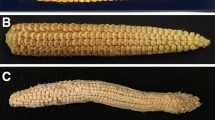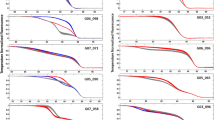Summary
It is difficult to assess self-incompatibility (SI) as a phenomenon or to distinguish it from other reproductive barriers. Our objective was to demonstrate a method of separating reproductive barriers and other factors affecting SI expression. The analysis consists of four parts: (1) calculating male (MCC) and female (FCC) coefficients of crossability using seed set from a diallel crossing design; (2) determining significant male and female differences using a 1∶1 paired Chi-square test; (3) constructing scatter diagrams of FCC versus MCC; (4) performing linear regression analysis between FCC and MCC. Diallel data from eight genera with various reproductive barriers were used to illustrate and validate the usefulness of this method. SI can be distinguished from other reproductive barriers (incongruity, inbreeding depression, post-fertilization phenomena) using 1∶1 Chisquare and regression analysis. In addition, the incorporation of ovule counts is crucial for demarcating the SI phenomenon in species where ovule numbers vary between self- and outcross pollinations. Male and female steriles can be identified with the MCC/FCC equations and subsequently removed from further analysis.
Similar content being viewed by others
References
Anderson NO, Liedl BE (1986) Genetic modeling of self-incompatibility in Poaceae utilizing SIGMAS-1. HortScience 21:845
Anderson NO, Liedl BE (1987) SIGMAS Version 2.0. A soft-ware program for self-incompatibility genetic modeling. Plant Cell Incomp Newslett 19:1–2
Anderson NO, Liedl BE, Larson DJ, Ascher PD (1987) Genetic and evolutionary studies of self-incompatibility (SI) using rapid cycling Brassicas. Proc Crucifer Improvement Cooperative Workshop IV:27
Anderson NO, Liedl BE, Ascher PD (1988a) Formulating incompatibility genetic models: the theoretical uses of ITS and ITC. Genome 30 [Supp 1]:291
Anderson NO, Liedl BE, Ascher PD, Widmer RE, Desborough SL (1988b) Evaluating self-incompatibility in Chrysanthemum. The influence of ovule number. Sex Plant Reprod 1:173–181
Ascher PD (1976) Self-incompatibility systems in floriculture crops. Acta Hortic 63:205–215
Campbell RB (1988) Mating structure and the cost of deleterious mutation. I. Postponing inbreeding. J Hered 78:179–183
Carroll CP, Low RJ (1975) Flowering behaviour and self fertility in dihaploid Solatium tuberosum. Potato Res 18:416–427
Compton RH (1912) Preliminary note on the inheritance of self-fertility in Reseda odorata. Proc Cambridge Philos Soc 22:7
Correns C (1912) Selbsterilität und Individualstoffe. Festschrift zur 84. Versammlung Deutscher Naturforscher und Ärzte in Münster in Westfalen, issued by the Medizinisch-Naturwissenschaftlichen Gesellschaft zu Münster, pp 186–217
Correns C (1913) Selbsterilität und Individualstoffe. Biol Zentralbl 33:389–423
Darwin CR (1876) The effect of cross- and self-fertilization in the vegetable kingdom. John Murray, London
DeNettancourt D (1977) Incompatibility in angiosperms. Springer, Berlin Heidelberg New York
East EM, Mangelsdorf AJ (1925) A new interpretation of the behaviour of self-sterile plants. Proc Natl Acad Sci USA 11:166–171
Gardner CO, Eberhart SA (1966) Analysis and interpretation of the variety cross diallel and related populations. Biometrics 22:439–452
Gerstel DU (1950) Self-incompatibility studies in guayule. II. Inheritance. Genetics 35:482–506
Haghighi KR, Ascher PD (1988) Fertile, intermediate hybrids between Phaseolus vulgaris and P. acutifolius from congruity backcrossing. Sex Plant Reprod 1:51–58
Hardon JJ (1967) Unilateral incompatibility between Solanum pennellii and Lycopersicon esculentum. Genetics 57:795–808
Haruta T (1966) Studies on the genetics of self- and cross-incompatibility in cruciferous vegetable. Northrup King & Co, Minneapolis
Hayward MD, Wright AJ (1971) The genetic control of incompatibility in Lolium perenne L. Genetica 42:414–421
Hermsen JGT (1979) Factors controlling interspecific crossability and their bearing on the strategy for breaking barriers to intercrossing of tuber-bearing Solanum species. In: Proc Conf Broadening Genet Base Crops, Wageningen, pp 311–318
Hogenboom NG (1973) A model for incongruity in intimate partner relationships. Euphytica 22:219–233
Hogenboom NG (1975) Incompatibility and incongruity: two different mechanisms for the non-functioning of intimate partner relationships. Proc R Soc London Ser B 188:361–375
Hogenboom NG (1984) Incongruity: non-functioning of intercellular and intracellular partner relationships through non-matching information. In: Linskens HF, Heslop-Harrison J (eds) Cellular Interactions. (Encyclopedia of plant physiology, NS, vol 17). Springer, Berlin Heidelberg New York, pp 641–654
Hughes MB, Babcock EB (1950) Self-incompatibility in Crepis foetida subsp. rheaedifolia. Genetics 35:570–588
Hummel R, Ascher PD, Pellet HM (1982) Genetic control of self-incompatibility in red osier dogwood. J Hered 73:308–309
Jost L (1907) Über die Selbsterilität einiger Blüten. Bot Z 65:77–117
Lande R, Schemske DW (1985) The evolution of self-fertilization and inbreeding depression in plants. I. Genetic models. Evolution 39:24–40
Lawrence MJ, Marshall DF, Curtis VE, Fearon CH (1985) Gametophytic self-incompatibility re-examined: a reply. Heredity 54:131–138
Lewis D, Crowe LK (1958) Unilateral interspecific incompatibility in flowering plants. Heredity 12:233–256
Liedl BE, Anderson NO (1986a) Incompatibility hermeneutics: the determination of cutoff values. Plant Cell Incompat Newslett 18:6–12
Liedl BE, Anderson NO (1986b) SIGMAS-1: A software program for self-incompatibility genetic modeling. J Hered 77:480
Liedl BE, Anderson NO, Desborough SL, Ascher PD (1988) Empirical evidence for the use of ITS/ITC in determining cutoff values for genetic modeling of incompatible Solanum. Genome 30 [Supp 1]:291
Lillie FR (1913) The mechanism of fertilization. Science 38:524–528
Maletsky SI, Weisman NJ (1978) A population genetic analysis of self- and cross-incompatibility in sugar beet (Beta vulgaris L.). Theor Appl Genet 52:21–28
Morgan TH (1910) Cross- and self-fertilization in Ciona intestinalis. Arch Entwicklungsmech Org 30:206–234
Padrutt JA (1988) Post-pollination reproductive biology of Rhododendron prinophyllium (Small) Millais. MS thesis, University of Minnesota
Poehlman JM (1979) Breeding field crops. AVI Publication, Westport, p 470
Robacker C, Ascher PD (1981) Discriminating styles (DS) and pollen-mediated pseudo-self-compatibility (PMPSC) in Nemesia strumosa Benth. I. Characteristics and inheritance of DS. Theor Appl Genet 60:297–302
Robacker C, Ascher PD (1982) Discriminating styles (DS) and pollen-mediated pseudo-self-compatibility (PMPSC) in Nemesia strumosa Benth. II. Origin of PMPSC and nature of the DS-PMPSC interaction. Theor Appl Genet 61:289–296
Ruemmele BA (1988) Reproductive biology in Poa annua L. PhD thesis, University of Minnesota
Seavey SR, Bawa KS (1986) Late-acting self-incompatibility in angiosperms. Bot Rev 52:195–219
Spoor W, McCraw JM (1984) Self-incompatibility in Lolium: a reply. Heredity 53:239–240
Stein J, Su PR (eds) (1978) The Random House dictionary. Ballantine Books, New York
Vander Kloet SP, Cabilio P (1984) Annual variation in seed production in a population of Vaccinium corymbosum L. Bull Torrey Bot Club 111:483–488
Wallace DH (1979) Interactions of S alleles in sporophytically controlled self-incompatibility of Brassica. Theor Appl Genet 54:193–201
Wiens D (1984) Ovule survivorship, brood size, life history, breeding systems, and reproductive success in plants. Oecologia 64:47–53
Williams EG, Knox RB, Rouse JL (1982) Pollination sub-systems distinguished by pollen tube arrest after incompatible interspecific crosses in Rhododendron (Ericaceae). J Cell Sci53:255–277
Author information
Authors and Affiliations
Additional information
Scientific Journal Series Paper Number 16,686 of the Minnesota Agricultural Experiment Station
Order of the first two authors was statistically determined by replicated tosses (n = 10) of a penny (US currency)
Rights and permissions
About this article
Cite this article
Anderson, N.O., Liedl, B.E., Ascher, P.D. et al. Distinguishing between self-incompatibility and other reproductive barriers in plants using male (MCC) and female (FCC) coefficient of crossability. Sexual Plant Reprod 2, 116–126 (1989). https://doi.org/10.1007/BF00192000
Issue Date:
DOI: https://doi.org/10.1007/BF00192000




